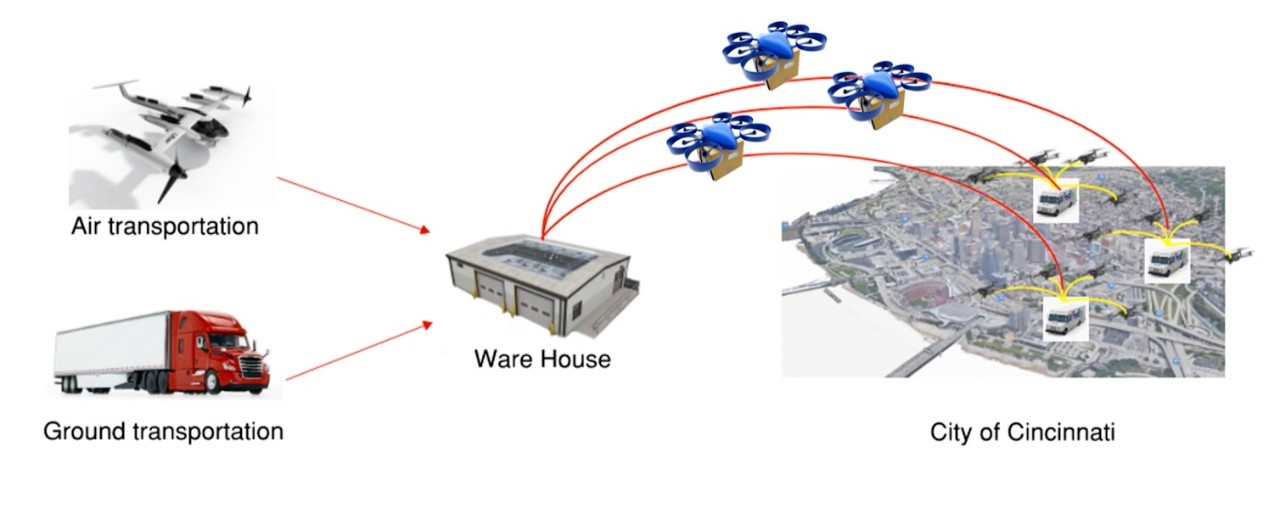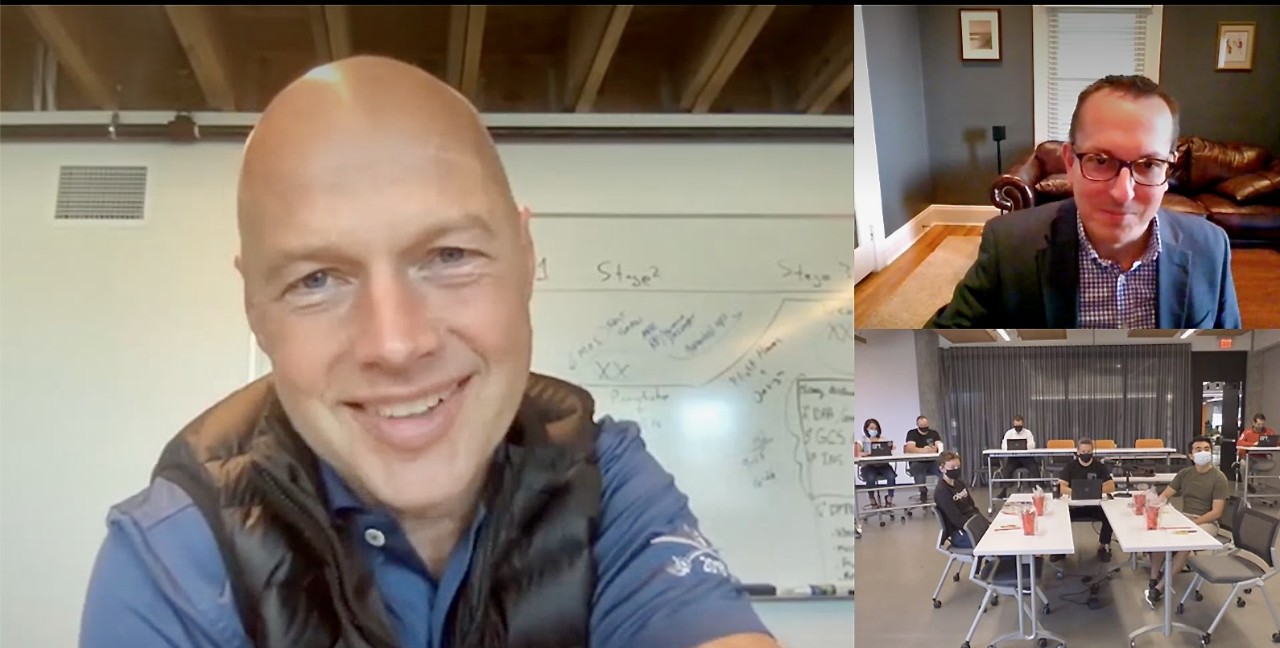
Sky’s not the limit in student innovation challenge
CID, UC aerial vertiport student challenge leads to ‘creative collisions’ across Ohio
Flying aerial drones moving goods, medical supplies — and even people — could soon be on the horizon thanks to a multi-collaborative FlyOhio Vertiport Innovation Challenge hosted by the Cincinnati Innovation District ® (CID) in the University of Cincinnati’s 1819 Innovation Hub.
During the recent FlyOhio think-tank, student teams from six universities across the state of Ohio, the birthplace of flight, collaborated with world-class Advanced Air Mobility (AAM) industry experts, including NASA, to activate UC and Ohio's student talent connection to solve important real world problems.
Their challenge? To create a network of vertiports serving their region of Ohio, integrated with smart mobility solutions on the ground. The ultimate goal is to enable the safe, easy and equitable movement of goods and people.
“FlyOhio and DriveOhio are twin initiatives of the Ohio Department of Transportation for the state center for smart mobility,” says Rich Granger, managing director of workforce and economic development at DriveOhio. “When we say smart mobility we mean automated, connected vehicles and infrastructure on the ground and in the air. That means self-driving cars, small drones and large aircraft that have the potential to be auto piloted and pretty much all electric.”
The inaugural FlyOhio Vertiport Innovation Challenge held in UC’s 1819 Innovation Hub in March of this year included only students from UC, but FlyOhio, CID and industry experts expanded the recent competition in an effort to build a strong community among institutions across Ohio.

University of Cincinnati's team one presents an efficient system for the small drone completion of a last-mile package delivery.
While the interdisciplinary teams from UC, Ohio State University, Sinclair College, University of Akron and the University of Toledo gained the opportunity to engage with other students from diverse backgrounds, they also collaborated with some of the world’s foremost experts in aviation, business, engineering, marketing and communications.
The event’s notable leaders from local and national industry such as Crown Consulting AAM, NEXA Capital Partners and UC faculty in aerospace engineering also included innovator, entrepreneur, educator, computer scientist and keynote speaker Sebastian Thrun.
“I’m excited to be here in the birthplace of flight,” said Thrun, CEO of Kittyhawk and chairman of Udacity. “Ohio is the center of aviation and innovation, and along with Kittyhawk in Silicon Valley, we have been working with Ohio for quite a while because right now Ohio is by far the most progressive, forward looking state in this nation and maybe even in the world when it comes to innovation and aviation.”
Innovative success through top-tier collaboration

Sebastian Thrun on left and Rich Granger in upper right were inspirational mentors for the innovation of advanced air mobility during the interdisciplinary student challenge event.
Thrun, who also founded GoogleX, Google’s self-driving car team, shared motivational messages that included his brief backstory about moving beyond the safety issues with self-driving vehicles to exploring the notion of flying cars.
“What if we could just fly a car to and from work, a car that could spread wings and fly up and out of traffic and finish the trip in the air?” says Thrun. “And that’s where we are today. Battery-powered air mobility can cut energy consumption relative to electric cars by a third, and relative to gas cars by less than 10%, making the air in cities much greener.”
Through panel discussions with industry professionals and a wealth of resources available throughout the event, students developed sustainable plans for AAM vehicle vertiports focusing on either medical use or cargo transport.
Each team matched their goals with one of the competition’s six phase-use case combinations, concentrating on how it would benefit the community, how it would avoid disruption through site location, how they would sustain it and how it would create more than 15,000 new jobs and convert existing jobs — generating more than a projected $13 billion in economic activity in Ohio over the next 25 years.
It’s great to see Ohio at the forefront of trying to design next generation vertiports. If you are a student, remember, the sky isn’t even the limit. You are young, you are in the beginning of your life and you have the right to dream and invent crazy stuff.
Sebastian Thrun CEO of Kittyhawk, founder of Google X
During the second phase of the competition, 13 teams from the two divisions (six teams from one division and seven from the other) presented their work and designs to their own panel of judges representing industry, universities and more than 30 sponsors.
The top two teams from each division were chosen; the four finalists advanced to the state championship held in-person in UC’s 1819 Innovation Hub on the third weekend.
Wowing the judges during the final presentations, Sinclair University was awarded first place for best idea and Ohio State University was awarded best presentation.
“Our cargo transport concept would be a faster method of travel with an improved impact on the environment versus traditional ground methods, and the efficiency and cost savings ensure a long-term return on investment,” says Sarah Brown, second-year unmanned aerial systems student at Sinclair Community College and member of the Fly Division winning team.
“With time, as people see that vertiports have low space and sound footprints, this will help drive common acceptance of further vertiport use around the state.”
Everyone who competed in the participation and presented after the first week received $100 for participating, with the first and second-place winners receiving additional cash prizes.
With Wright Patterson Air Force Base so close to Cincinnati and UC, the Cincinnati Innovation District is poised to become the beacon of aviation innovation for the state and the country, adds Granger.
“It’s great to see Ohio at the forefront of trying to design the next generation of these vertiports,” says Thrun. “If you are a student, remember, the sky isn’t even the limit. You are young, you are in the beginning of your life and you have the right to dream and invent crazy stuff.
“And it’s always been the dream of young inventors to change the world!”
Featured image at top: Advanced Air Mobility vehicles are a promising green and efficient alternative to ground transportation. Photo/Crown Consulting.

About the Cincinnati Innovation District®
The Cincinnati Innovation District® is a unique and thriving ecosystem that attracts, produces, retains and develops talent by co-locating and collaborating with organizations. The district envelops myriad innovation assets and access to some of the world’s leading academic and research centers, organizations and talent pools. Powered by the University of Cincinnati, the CID includes the world-renowned Cincinnati Children’s Hospital Medical Center and other national research centers. The district’s mission is to become a globally recognized talent hub and lead a transformational movement. The combination of industry engagement, unique experiential platforms and accessible research expertise — working at the pace of change — will become a model nationwide. For more information on the Cincinnati Innovation District, visit www.cincyid.com.
About UC's 1819 Innovation Hub
The nerve center of the Cincinnati Innovation District®. Home to startups and midsized and Fortune 500 companies, the 1819 Innovation Hub is an ecosystem that serves as a catalyst for collaboration for industry and talent. The 1819 Innovation Hub is the home to UC’s Office of Innovation, UC’s Venture Lab (a startup accelerator program), UC’s Makerspace, UC’s Office of Technology Transfer and 14 corporate partners who are seeking access to talent and proximity for cross-collaboration. Partners that are currently embedded include: Procter & Gamble, Kroger, FIS, Kingsgate Logistics, Cincinnati Bell, Kao Brands, Hillman Accelerator, CincyTech, Village Life Outreach Project, Fifth Third Bank, Cincinnati Insurance Company, Live Well Collaborative and Simpson Center for Urban Futures.
Innovation Lives Here
The University of Cincinnati is classified as a Research 1 institution by the Carnegie Commission, is ranked in the National Science Foundation's Top-35 public research universities and secured a spot on Reuter’s World’s Most Innovative Universities list. UC's students and faculty investigate problems and create innovative solutions with real-world impact. Next Lives Here
Related Stories
UC 1819 sewer tech startup makes a $7.5 million splash
March 31, 2025
A pioneering startup that emerged from the University of Cincinnati 1819 Innovation Hub’s Venture Lab pre-accelerator program in 2018, was recently acquired by global solutions provider IDEX Corporation for $7.5 million. Subterra, founded by Robert Lee, revolutionizes sewer and pipeline infrastructure monitoring through its innovative, AI-driven technology, which aligns with IDEX’s family of business solutions.
South by Southwest innovators break down the future of...
March 31, 2025
Top tech and media leaders congregated at South by Southwest 2025 to speak of the future of storytelling and offer tips. Below are our takeaways from four of the festival’s highlight sessions.
UC engineer applying generative AI to smart manufacturing
March 31, 2025
Manish Raj Aryal, a PhD student in mechanical engineering at the University of Cincinnati, is working on revolutionizing manufacturing systems through generative AI, leveraging AI systems to develop manufacturing assistant chatbots. He came to UC for his master's degree and continued researching as a PhD student. He was named Graduate Student Engineer of the Month by the College of Engineering and Applied Science (CEAS).
